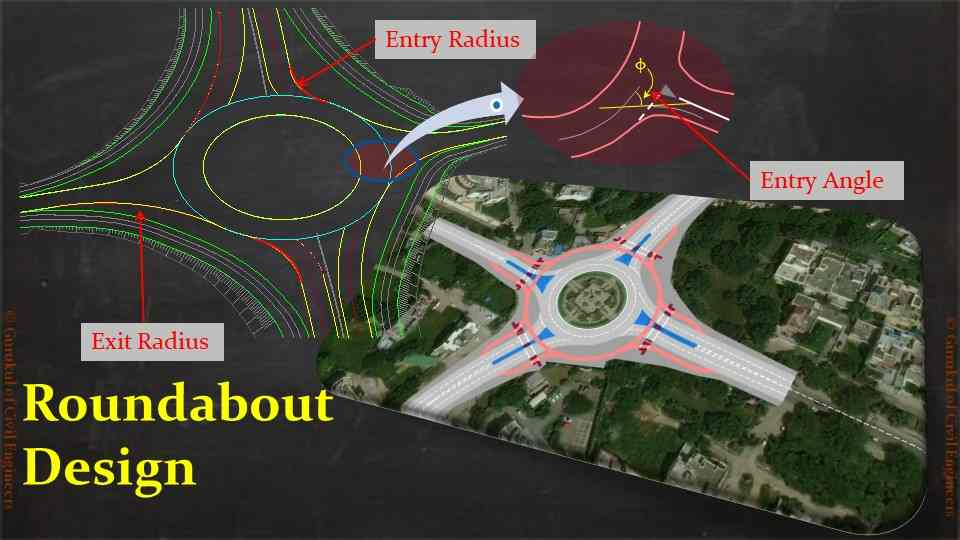How to design a Roundabout? 4 Important Points
- By
- Pooja |
- July 25, 2021 |
- Civil Engineering, Highway Engineering, Innovation,

Table of Contents
Inscribed circular diameter (ICD):
Roundabout Design Best Practices?
Pedestrian and Cycling Facilities at the Roundabout
What is Roundabout Junction?
A roundabout is a one-way, circular intersection where the traffic flows around a central island. Following are the key components of Roundabout:
Circulatory Carriageway:
The circular section of the road over the roundabout is called a circulatory carriageway.
Inscribed circular diameter (ICD):
The size of the roundabout is measured from its ICD means Inscribed circular diameter. ICD is measured from the outer edges of the circulatory carriageway passing through the centre of the roundabout.
Entry Point:
when a vehicle enters one of the arms of the roundabout, the first contact point is called the Entry point.
Central Island:
The central piece of the roundabout is called Central Island and it’s a non-trafficked area. it is not advisable to place trees, advertising boards, etc at the outer edge of the central island because it will create visibility obstruction to drivers.
Arms and Splitter Island:
The roads joining the roundabout are called Arms and splitter islands are provided at each arm to provide pedestrian crossing facilities.
Roundabout Design Guidelines?
UK DMRB CD116 (formerly known as TD16) is world known design guide for Roundabout Design. It covers a complete guide of geometric design of Roundabout, signal-controlled roundabout design, mini-roundabout design, and design of associated features like pedestrian footways, cycleways, etc.
Roundabout Design Best Practices?
A compliant design roundabout would surely be considered as a safe design for all road users, but best design practices coupled with design guidance make the infrastructure safe, economical, and eco-friendly by adding further values as below:
Entry Path Radius:
The entry path radius is a deflection imposed on the vehicles while entering the roundabout and it is the minimum best fir curve required to govern the speed of the vehicle to make the junction safe.
Roundabout Visibility:
It is very important to provide desirable minimum visibility to address the following conditions:
- Stopping Sight Distance at the Entry point
- Visibility along Circulatory of the Roundabout
- Exit Visibility
Swept Path Analysis:
Swept path analysis is one of the key design inputs of any junction design and Roundabout is no different, however, Roundabout provides a free flow movement with Right of Way (RoW) and give-way operation facilities, its very important that swept path is carried out following similar operational parameters and the most onerous vehicle is used for the swept path analysis.
To understand the swept path analysis in great detail, please see our blog “What is Swept Path Analysis? 6 Important Points”.
Pedestrian and Cycling Facilities at the Roundabout
Pedestrian and cyclist facilities play a very important role especially in the case of urban street design. The facilities for disabled users, visually impaired users, wheelchair users are as important as for vehicular traffic.
Therefore, it is very important for the designer to consider longitudinal gradient, cross-falls, drop kerb locations, refuge islands locations, tactile, segregation between pedestrians and cyclists, etc adequately and develop a robust junction layout to facilitate the road user movements efficiently and comfortably.
Read More:
Innovative Roundabouts
Innovation is the mantra of consistent improvement in any field and it applies to the Roundabout design too. Various value engineering and innovative solution has been implemented in the roundabout design. Following are the two well-known Innovative Roundabout design that has been constructed in European countries like Netherland, the UK, etc.
Dutch Style Roundabout
Dutch Style Roundabouts are suitable for urban junctions where high pedestrian movement is expected. Dutch-style roundabout provides a low-speed vehicular traffic environment and segregated high-end pedestrian and cycle facilities. Along with this, the roundabout provides robust facilities for disabled road users, visually impaired road users, wheelchair and pushchair road users.
We have developed an online course on Dutch Style Roundabout Design and it covers all the key aspects of the design in five unique modules as below:
- Topo Survey Review
- Roundabout Channel and Crown Line Design
- Cycle Track and Cycle Lane Design
- Footway and Segregated Crossing Facilities
- General Arrangement Drawing
I would highly encourage you to sign-up for this course and get the full benefit out of it. The course is one of its kind and comes with the best design practices of roundabout design.
Turbo Roundabout
Turbo Roundabout is another very innovative roundabout concept that provides spiral traffic flow at the junction to increase capacity and make the junction safer by reducing the number of conflict points. Turbo Roundabout was first constructed in Netherland and since then it has gained immense popularity.
Advantage of Turbo Roundabout:
Reduction in conflict Points:
Standard dual-lane entry/ exit roundabout comes with 16 conflict points (12 at entry, 2 at weaving, and 2 at cut-in, however, Turbo Roundabout reduces it to 10 conflict points at the entry.
Low-Speed Environment
Standard dual-lane entry/ exit roundabout provides 40kph to 50kph speed during off-peak times, therefore may fly through the junction and generate a potential for accidents. However, Turbo Roundabout provides a low-speed environment of 30kph to 35khp speed during the off-peak hours and creates a relatively safer environment.
Higher Junction Capacity:
Due to its innovative geometric design, Turbo Roundabout normally provides 25% to 30% additional capacity to the junction. I hope the blog provides you with adequate information on the roundabout and its associated features.
Please feel free to like, share and comment.
Admin, gcelab.com Please see our Pillar Post to know why we founded gcelab.com.
Read More:
- What are As-Built Drawings in Construction? 6 Important Points
- 30 Most demanding and useful design software for Civil Engineers
- What is Swept Path Analysis? 6 Important Points
- Highway Engineering Online Course: 5 Important Modules

Pooja
Founder at gcelab.com, Pooja is an Entrepreneur unlocking human potential. Working in the Principles of Lean Start-up, Pooja believes in Transparency and User Happiness the most. Pooja’s background in teaching gives her a sophisticated grasp on even the most tedious aspect of course building. She is passionate about people who believe that good is not enough.

